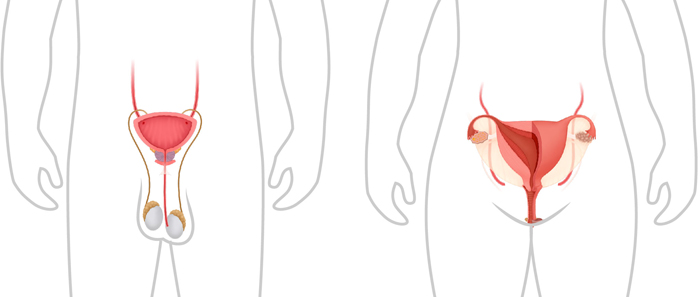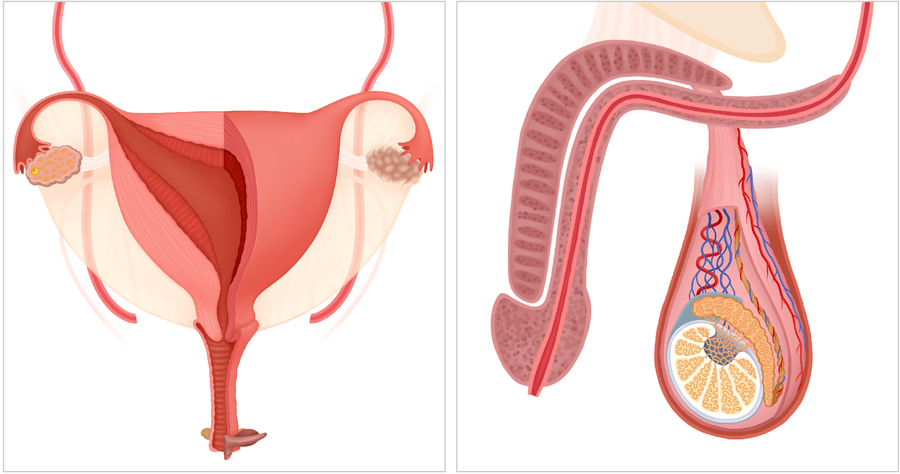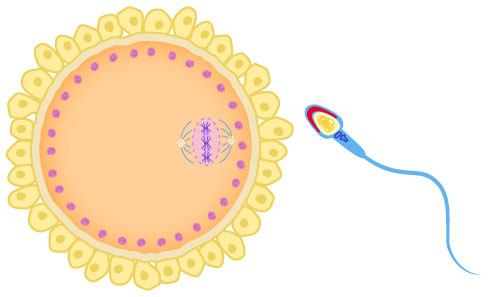Introduction
The human reproductive system
For a species to survive, some of its members must reproduce. This means that every animal has body parts that help it with this process. In humans, we have some reproductive body parts that you can see, and others on the insides of our bodies that you can't see. Humans usually reproduce by having sex, to join female and male sex cells (eggs and sperm). Because some people need to reproduce for our species to survive, the reproductive system is a very important body system.
This game will help you learn some basics about what female and male reproductive systems look like and how they work. You can visit the anatomy section to learn about specific body parts, or go to the pregnancy pathways section to learn more about how pregnancy happens and how it can be prevented. There are also links in the menu to learn more about cell division, fertilization, and the menstrual cycle. But let's cover some of the first basics here, to start.

Body part diversity
We are all born with reproductive body parts, but they aren't something that we usually talk about. Your reproductive body parts probably look different from those of other people, and they will change over time. Because we don't usually talk about them, some people can worry about their parts and whether they are healthy or "normal" or not.
Vulvas and penises can be different shapes, colors, and sizes, just like your eyes, lips, and noses. There is no "normal". Your sex parts also don't have to determine your gender.
It is important to get to know your sex body parts so that you can tell when something changes or isn't working the way it usually does. This is a good start to making sure your reproductive system stays healthy.
From puberty to pregnancy
Before the human body is ready to reproduce, it must grow and go through puberty. During puberty, people may notice hair growing in places it didn't grow before, such as on their faces, armpits, and pubic regions. Girls may start making more female sex hormones and start having a menstrual cycle, and their hips often grow wider. Boys may start making more male sex hormones and their testes often lower a bit, which lets them make healthy sperm. After puberty, sex between a male and a female can result in a pregnancy.
Both male and female reproductive systems rely on hormones to work properly. Hormones control many things, including when eggs are released from an ovary and when a period starts. Hormones also help make healthy sperm in males. Because of the role hormones play in the menstrual cycle, they are often used in birth control.

Sex cells
Sex cells – eggs and sperm – are made through meiosis. These cells have half the DNA that most other cells in the body have. Males can make an unlimited number of sperm cells throughout their lives. But females are born with a specific number of eggs. At around age 50, women run out of those eggs, which is called menopause. At that time, they stop having a menstrual cycle and usually can no longer reproduce. A woman's "reproductive years" are from puberty to menopause, when she has regular periods. The only visible sign of a menstrual cycle is menstrual bleeding. Having a regular period is a sign of fertility and overall health. Each cycle, an ovary releases one egg, which only lives for up to a day. If that egg is found by live sperm, the egg can be fertilized and begin to develop through mitosis. While getting pregnant may seem easy, many people struggle to get pregnant because many things can go wrong.

Be a Repro Pro
These are just a few basics to get you thinking about the reproductive system, and the body parts that are a part of it. As you explore the different parts of the reproductive game, there are a few good questions to ask yourself:
- What things did you get wrong? Maybe you learned about the reproductive system somewhere else... from a book, or from friends. Was everything you learned correct? Many people have misconceptions (or misunderstandings) about the reproductive system. For example, some people think that urine exits through the vagina (it doesn't), or that sperm only live for a day (they live for up to five!)
- What things are important to your future? Perhaps you will find information about periods or testosterone that you didn't know, but that relate to your own health. You may also learn about the importance of consent for any sexual activity. Or maybe you will learn how well some birth controls work to protect against infection, or prevent pregnancy, if you decide to be sexually active.
- What types of issues do other people deal with? It's also important to learn about the struggles other people have. Many women have painful and abnormal periods, and many men are at risk for prostate cancer. Understanding the reproductive health issues of other people can help you support friends or future partners.